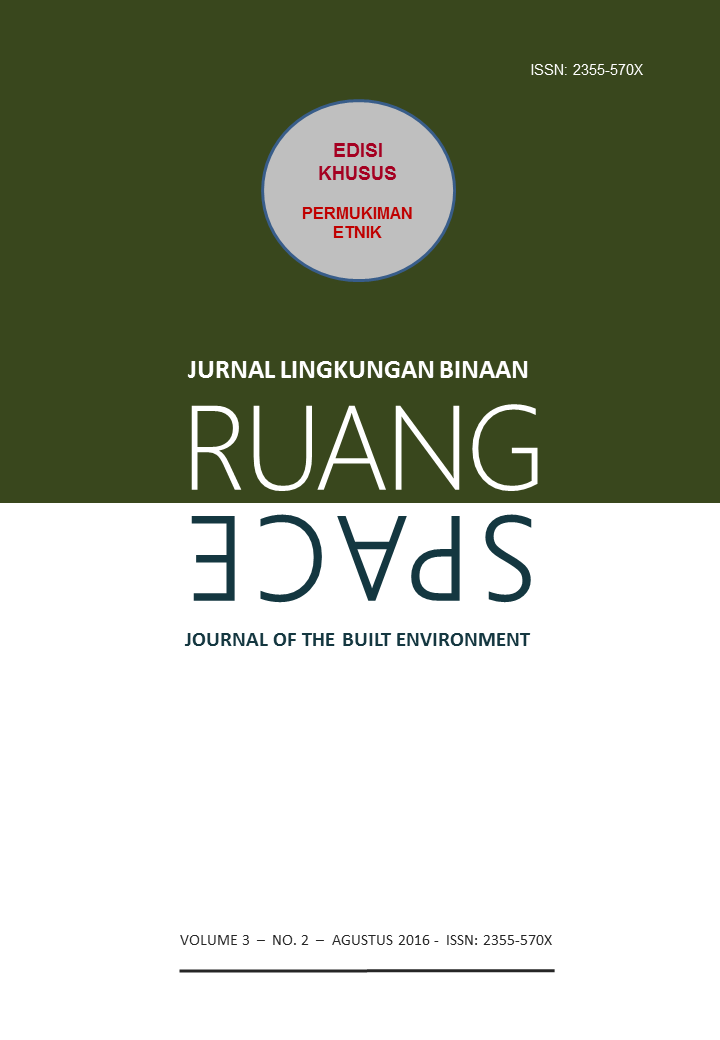EKSISTENSI TRADISI BALI AGA PADA ARSITEKTUR RUMAH TINGGAL DI DESA PAKRAMAN TIMBRAH
Abstract
This article discusses the uniqueness of Bali Aga settlements, focuses its observation on belief systems, house forms, the organization of the surrounding environment, and how these attributes have either evolved or revolutionized for various reasons. Differences in geographical position and social development have in subsequent contributed to the complexity of these attributes and their representations within one village or another. Taking Timbrah Village of Karangasem Regency of Bali as its locus of study, this research finds that minor adaptations have occurred on the lay-outing of the village at a macro level, while revolutionary changes happens at the domestic level. The latter encounter is inevitable following the elimination of karang paumahan (the site where traditionally formed homes are constructed upon). Such a shift is further enabled by an improved financial state of many households which leads to the thriving home-renovation related activities. This however is larger than a mere case of affordability. It is frequented by other grounds including, first, a need for spatial arrangement to comfortably accommodate the current lifestyle of the inhabitants; and second, a necessity to have flexible and multi-function spaces/rooms that can be interchangeably used for both ritual and living purposes. All of these forces have created a firm basis for the erection of non-traditional style buildings, leaving the least, if not zero, concerns in regard to the perpetuation of the bale adat (tradition-based building). Nevertheless, there are two elements of home unique to Timbrah that remain untouched. First is an unfenced sanggah (family shrine), and second is the lelompong/pemedal (entry) for the taksu desa (a female virgin whose presence is required during each ritul ceremony (bali aga ritual) held by the village).
Keywords: bali aga, tradition, taksu, Timbrah village
Abstrak
Keunikan yang dimiliki oleh masyarakat/desa Bali Aga meliputi hampir setiap aspek kehidupan dari sistem kepercayaan, sistem budaya sampai pada perwujudan fisik rumah dan lingkungannnya walau dengan derajat keragaman dan kedalaman yang berbeda antara satu desa dengan lainnya. Tradisi Bali Aga umumnya dilakukan secara konsisten termasuk di Desa Pakaraman Timbrah, Karangasem yang sampai saat ini tetap menjalankan keunikan tradisi adat dan struktur pemerintahan desa. Dari sisi fisik, pada tataran makro, tatanan ruang tradisi masih terlihat walau telah terjadi penyesuaian. Perubahan cepat justru terjadi pada bangunan rumah tinggal yang ditandai dengan semakin berkurangnya karang paumahan yang di dalamnya terdapat bangunan bali/bale adat yang ketika dilakukan renovasi dapat dipastikan dirubah menjadi bangunan dengan style modern atas nama tuntutan kebutuhan ruang, kenyamanan dan fleksibilitas pemanfaatan ruang bagi ritual keagamaan pada tingkatan rumah tinggal. Eksistensi tradisi bali aga pada arsitektur rumah tinggal di Desa Timbrah masih nampak pada karakteristik bangunan sanggah dan adanya lelompong/pemedal taksu yang keduanya berkaitan erat dengan peran salah satu anggota keluarga sebagai (seorang) taksu desa yang merupakan salah satu bagian penting dari pelaksanaan tradisi ritual bali aga.
Downloads
Keywords
The copyright of the received article shall be assigned to the journal as the publisher of the journal. The intended copyright includes the right to publish the article in various forms (including reprints). The journal maintains the publishing rights to the published articles.



